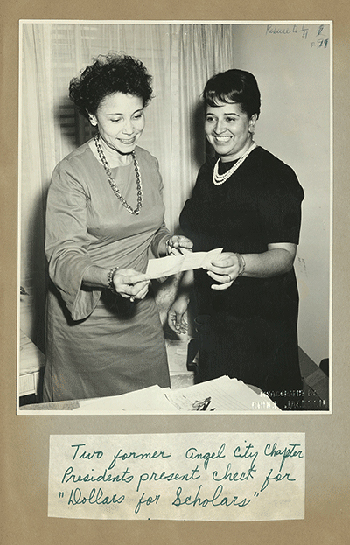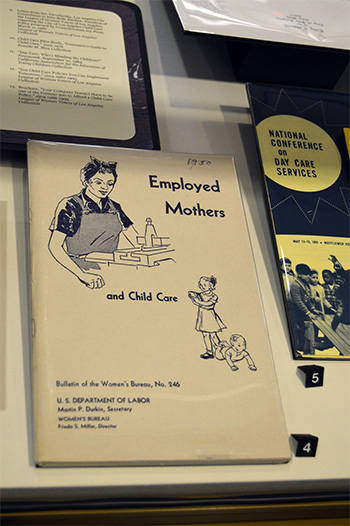Newsletter Edition: Fall 2018

(Links, Inc., Angel City Chapter Collection)
Contributed by Library Web Services Coordinator Elizabeth Altman
September 20, 2018 saw the lively opening of the Oviatt Library Special Collections & Archives exhibit, What She Said: 100 Years of Women's Civic and Community Engagement. The exhibition, which documents the rise of women’s engagement in civic, social and business life beginning in the late 19th century, was celebrated by almost 150 attendees including two Los Angeles City Councilwomen. Nury Martinez, representing the 6th district, is a CSUN graduate and the first Latina elected to the Los Angeles City Council representing the San Fernando Valley. She told a rapt audience of the trials she faced trying to break into her career with inspiring words for the future female activists in the audience: “It is up to us to be our own heroes, and to stand up and get elected. It’s about time that we not only cast our vote, but also take our seat at the table.” The second speaker was Monica Rodriguez, representing the 7th district. While serving on the Board of Public Works, she created The Small Business Academy to help women compete for city contracts. Having run for City Council in 2008 and lost, she was determined to create more opportunities for women, so she got involved with and later became president of Latinas Lead California. She realized, “there’s a role for each of us to play in this work...to help elect more women, to help create an environment that inspires other women to be the best that they want to be.”
After the speaker program, visitors adjourned to the Library Exhibit Gallery to experience the exhibition, enjoy gourmet snacks (generously furnished by the Friends of the Library), and socialize. The exhibition is curated in three parts: Votes for Women, Women Together, and Issue Spotlights, which presents women’s active influence in significant political reforms such as the environment, wage equity, and childcare. “As we approach the 100th anniversary of the 19th amendment, it was important to present the story of how voting rights were achieved,” says Ellen Jarosz, Head of Special Collections & Archives and one of the curators of the exhibit. The 19th Amendment to the United States Constitution, which granted women the right to vote, passed House and Senate in 1919, but 36 states had to ratify it before it became law in August 1920. “Fortunately, the exhibit also coincides with a midterm election season in which unprecedented numbers of women are running for public office, and many women’s issues are at the forefront of our politics. We always try to lend historical context to current social, cultural and political phenomena in our exhibits, and give some idea of how significant debates have moved and changed over time. Paramount, of course, is connecting students and faculty to resources they can use to explore those shifts for their own academic work.”

(Baldwin-Shaffner Family Collection)
Nancy, a CSUN student, came to get extra credit in her Women and Religion class. “Just hearing the councilwomen talk about their struggles made me realize that it hasn’t been that long since we got the vote, and that we’re still fighting for women’s rights. It’s been more than 100 years, honestly, and we’re still in the background, in some ways. Hearing that Nury Martinez was the first woman of color from the valley to be elected to the LA City Council makes me realize what other things we haven’t had, like a female president. You know, we see a lot of women in the workforce now, but when it comes to higher up, managers or CEOs, majority of the positions are filled by men. So we’re still trying to fight for the right to be equal.”
Both the Women Together and the Issue Spotlights segments feature papers of women's clubs and associations active in Greater Los Angeles and the San Fernando Valley. The curators drew heavily on materials from the Young Women’s Christian Association (YWCA), League of Women Voters, The Links Inc., and included materials from many other groups such as Comisión Feminil and Mothers of East Los Angeles (MELA). “Women’s groups are important to the story because they brought individual women together and empowered them to work as a team to tackle issues facing their communities, like childcare, healthcare, and other issues in everyday life,“ says Mallory Furnier, an Archivist in Special Collections & Archives, and a member of the curation team for this exhibit. “The YWCA in particular was a very inclusive local organization, providing support and community to women of all backgrounds, cultures, and classes. The organization provided housing for single women coming to Los Angeles for work, as part of combating the previously negative public perception of unmarried women living solo in an urban environment.”

(Rosalie M. Blau Collection)
One of the most challenging aspects of putting together the exhibit, Mallory observed, was the effort to give effective coverage to so many broad issues. Unfortunately, some stories were left out. Ariana Edmonds, however, was impressed by the inclusiveness of the suffrage history. “It describes the power of the suffragist movement, and how important it was, but it also talks about how some of the leaders actively excluded women of color and women who were uneducated. I love when exhibitions and galleries try to tell the whole story, because it’s easy to exclude the things that that make people uncomfortable. Even by saying that there was exclusion, they have included us in the story and didn’t eliminate our existence.” Edmonds herself had come to consult with Oviatt Library archivists about a family archival project, the preservation of the papers of her great grandfather, Jefferson Lewis Edmonds, founder of the first black newspaper in the Los Angeles area, The Liberator.
The stories begun in Votes for Women and Women Together gain contemporary perspective in Issue Spotlights. “The story of suffrage and women’s associations provide a foundation for the essential topics we wanted to examine in the third part of the exhibition,” explains Holli Teltoe, Special Collections & Archives Coordinator, another member of the curation team. “What we consider to be key issues -- like reproductive rights -- started with health issues like workplace safety, healthcare for the poor. We are hoping that displays on topics like the ERA show how historical successes of and challenges to women’s movements are still relevant to contemporary political concerns.”
Come visit What She Said: 100 Years of Women's Civic and Community Engagement now through July 1, 2019. Use our audio tour, featuring voices of CSUN students and Oviatt Library personnel, to navigate the gallery.
